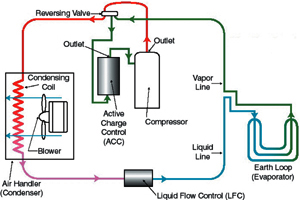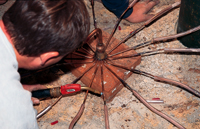Copper Key to Most-efficient Home Heating and Cooling
 Schematic of the geothermal HVAC system in heating mode. Note only one heat-exchange operation, between refrigerant and air, is necessary. (Water-based geothermal systems require a second heat exchange between the water and the heat pump refrigerant.) To cool, the flow of refrigerant is reversed.
Schematic of the geothermal HVAC system in heating mode. Note only one heat-exchange operation, between refrigerant and air, is necessary. (Water-based geothermal systems require a second heat exchange between the water and the heat pump refrigerant.) To cool, the flow of refrigerant is reversed.Surfing the Internet while planning a new home for his family, Del Leese learned about the latest in geothermal heating/ventilating/air conditioning (HVAC) systems. The result: an efficient direct exchange geothermal (DXG) heat pump for his family's new 3,000-square-foot home in Mechanicsburg, Pennsylvania.
The key to the high efficiency of the unit Leese selected from ECR Technologies, Inc., Lakeland, Florida, is the use of high-thermal-conductivity copper tube instead of low-conductivity plastic. The buried tubing takes advantage of the year-round 55°F average earth temperature starting from four feet below the surface.Unlike earlier water-based geothermal systems, ECR's "Direct Axxess" unit uses a refrigerant, R-22, which eliminates one heat-exchanger step (see diagram below) and its concomitant need for electricity. R-22, which is not one of the federally banned chlorinated fluorocarbons, transfers heat much faster than water.
The refrigerant circulates through 14 copper loops, each extending down 50 feet into the earth outside Leese's home. They were placed in holes drilled diagonally into a four-foot-deep excavation in the backyard (see photo below). The loops, fabricated by ECR, consist of 3/8-inch OD tubing for heat transfer linked to 3/16-inch OD tubing to conduct the condensed refrigerant. The loops were joined together at their tops to a copper manifold (see photo below). From the manifold, the refrigerant flows back and forth through two copper tubes leading to the nearby basement of the home. These two horizontal tubes were laid in four-foot-deep trenches to avoid heat loss.
 Set in a four-foot-deep excavation, a copper manifold is joined to the 14 loops and then buried. Two horizontal tubes that connect the manifold to the DXG system are buried in a four-foot-deep trench.
Set in a four-foot-deep excavation, a copper manifold is joined to the 14 loops and then buried. Two horizontal tubes that connect the manifold to the DXG system are buried in a four-foot-deep trench. One of 14 refrigerant-bearing loops of copper tubing is inserted into a hole drilled diagonally into the earth. After the 14 loops, each 50 feet long, are in place, the 2-inch-wide holes are filled with a sand and water slurry.
One of 14 refrigerant-bearing loops of copper tubing is inserted into a hole drilled diagonally into the earth. After the 14 loops, each 50 feet long, are in place, the 2-inch-wide holes are filled with a sand and water slurry.Before beginning this installation, the chemistry of the earth around the home site was tested and found to be suitable. This means the copper tubing should last for many decades. If the earth had characteristics that would be aggressive to copper, special protective measures would have been needed.
Before beginning this installation, the chemistry of the earth around the home site was tested and found to be suitable. This means the copper tubing should last for many decades. If the earth had characteristics that would be aggressive to copper, special protective measures would have been needed.
Heats Water, Too
Once inside the home, the two horizontal tubes are connected to the HVAC system. In winter, the refrigerant they transport is compressed to form a gas of about 100°F to 108°F, which is used to heat the indoor air and domestic water. In summer, the system cools the home, and its waste heat is used to heat water which is stored in an 80-gallon water heater with supplemental electric heating. No fossil fuel is required by the DXG system. And, according to Leese, a consultant to the petroleum industry, this is "a huge plus."
The air-handling unit of the system can be installed either indoors or outdoors. The Leese's is indoors, an aesthetic advantage. The entire DXG copper-based system costs about twice as much as a conventional system. However, the difference is recouped in only a few years, depending on the cost of power and local climate, because a DXG unit can be up to 40% efficient, or more, according to tests conducted by Michigan and Florida electric utility companies.
Once this return on investment is achieved, the Leese family will enjoy continued energy savings for many years, while adding to the resale value of the home, should the Leeses ever sell it.
 The HVAC system in the basement. The 80-gallon water heater is at the left. To its right is the compressor. Farther right is the exchanger that heats the interior air in winter and cools the air in summer.
The HVAC system in the basement. The 80-gallon water heater is at the left. To its right is the compressor. Farther right is the exchanger that heats the interior air in winter and cools the air in summer.DXG systems using refrigerants running through copper tubing should be given a boost by a recently established Air Conditioning Research Institute standard, ARI 870. The standard provides a basis for the independent testing and monitoring of direct-exchange systems to ensure they meet strict operating and safety requirements. American Geothermal DX, Murfreesboro, Tennessee, also manufactures DXG systems. Other suppliers and additional pictures of the Leese installation can be found in our Tube, Pipe & Fittings section.
Jeff Demme of Demme Mechanical Contracting, Drumore, Pennsylvania, supervised the Leese home installation in collaboration with Huffman Mechanical, Shermandale, Pennsyvlania. After excavating for the manifold and drilling the 50-foot holes, it took two men only two days to install the entire system. All 1,400 feet of Type L tube was supplied to ECR by National Copper, Huntsville, Alabama, and Wolverine Tube, Decatur, Alabama.
Demme: 800/257-8540
ECR: 941/688-0880
Huffman: 717/974-5320
National Copper: 800/622-8945
Wolverine Tube: 800/633-3972
Also in this Issue:
- Copper Quality at Lower Cost
- Energy-Saving Software
- The Advantages of "Engineered"
- Copper Key to Most-efficient Home Heating and Cooling
- Leonardo’s Bronze Horse Installed
- Copper-The Metal for Every Millennium
- Copper Spacecraft to Thrill the World
